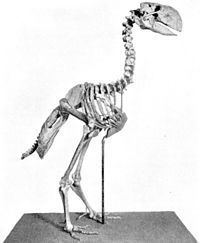Kingdom Animalia Phylum Chordata Rank Family | Scientific name Gastornithidae Higher classification Anseriformes Order Anseriformes | |
 | ||
Similar Bird, Gastornis, Anseriformes, Dinosaur, Dromornithidae | ||
Gastornithidae
Gastornithidae is a family of prehistoric birds. The various species in this group lived from the Paleocene to the Eocene epochs and ranged from Asia and Europe to North America. All known species were very large, flightless ground birds, similar to ostriches but more heavily built and with huge beaks. Once thought to be carnivores, they are now considered to have been primarily herbivorous.
Contents
They apparently evolved in isolation in Europe, an island continent in the Paleocene and parts of the Eocene, before dispersing to other landmasses for a brief period of time. In this respect they resemble the elephant birds of Madagascar, also occurring in an otherwise mammal-dominated island environment where herbivorous birds exceed the largest local mammals in size.
Gastornithids are only known from a handful of species. The genus Gastornis itself contains three European species, as well as the North American species G. giganteus, a well-known prehistoric bird formerly classified as the distinct genus Diatryma. An Asian species, G. xichuanensis, was originally classified as the distinct genus Zhongyuanus. Apart from these, there are some indeterminate gastornithid species, including "Diatryma" cotei from the middle-late Eocene of France Additional, fragmentary fossils that are difficult to classify in any particular genus or species include remains found in Paleocene rocks of Walbeck, Germany, and the specimen YPM PU 13258 from early Eocene rocks of Park County, Wyoming, possibly a juvenile G. giganteus
Classification
Gastornis and its close relatives were long considered to be members of the order Gruiformes. However, the traditional concept of Gruiformes has since been shown to be an unnatural grouping. Beginning in the late 1980s and the first phylogenetic analysis of gastornithid relationships, consensus began to grow that they were close relatives of the lineage that includes waterfowl and screamers, the Anseriformes. Recognizing the apparent close relationship between gastornithids and waterfowl, some researchers classify gastornithids within the anseriform group itself. Others restrict the name Anseriformes only to the crown group formed by all modern species, and label the larger group including extinct relatives of anseriformes, like the gastornithids, with the name Anserimorphae. Gastornithids are therefore sometimes placed in their own order, Gastornithiformes.
A simplified version of the family tree found by Agnolin et al. in 2007 is reproduced below.
